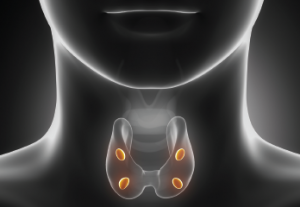
CLIPAREA l Custom media / SHUTTERSTOCK.COM
SAN DIEGO—A hormone secreted by the parathyroid gland is both a builder and a destroyer of bone in humans, with important implications for a variety of conditions treated by rheumatologists. In the Oscar Gluck, MD, Memorial Lecture at the 2017 ACR/ARHP Annual Meeting Nov. 3–8, Henry Kronenberg, MD, chief of the Endocrine Division at Massachusetts General Hospital and professor of medicine at Harvard Medical School, described the complex metabolic processes controlled by the parathyroid hormone (PTH).
Catabolic activity breaks down molecules for resorption and anabolic activity builds up or synthesizes complex molecules out of simpler ones. PTH is important in bone remodeling, the ongoing process in which bone tissue is alternately resorbed and rebuilt over time, and it is secreted in response to low blood serum calcium levels.
“We think PTH exists primarily to increase calcium as the main calcium-regulatory peptide in the body,” Dr. Kronenberg said.
Blood calcium and PTH act promptly to regulate each other in the body. PTH also indirectly stimulates osteoclast cell activity within bone marrow, and increases the number and activity of osteoblasts by increasing the numbers of precursor cells to osteoblasts.
“It’s not an accident that bone formation and absorption are coupled,” Dr. Kronenberg said in his lecture. The proper maintenance of bone over time requires a balance between the formation of new bone tissue and the breakdown and removal (resorption) of old bone tissue.
The proper maintenance of bone over time requires a balance between the formation of new bone tissue & the breakdown & removal (resorption) of old bone tissue.
Dr. Kronenberg also outlined some of the medical conditions affected by these complex mechanisms, including bone disease in rheumatology or back injury, glucocorticoid-induced osteoporosis and humoral hypercalcemia of malignancy.
Sclerosteosis, a mutation in the SOST gene, and Van Buchem disease, caused by a defect in genetic lesions, are examples of diseases that build bones to a harmful degree by suppressing sclerostin—a secreted glycoprotein encoded by the SOST gene in humans. Sclerostin’s main function is to inhibit bone formation. PTH acts to transiently suppress sclerostin synthesis and secretion by osteocytes; this is one of the ways that PTH increases bone formation.
Other health problems that result from too little or too much PTH (e.g., hypoparathyroidism, hyperparathyroidism and paraneoplastic syndromes) can wreak havoc in the form of bone disease, hypocalcemia and hypercalcemia.
Ultimately, Dr. Kronenberg said, PTH is a good banker, because the hormone causes bone to slowly store calcium, so the body can make withdrawals of calcium as needed to keep its appropriate level in the blood through ever-present challenges of metabolism, stress and nutritional variation. PTH is a key that unlocks the bank vault to remove the calcium and make sure the calcium is there when it’s needed.